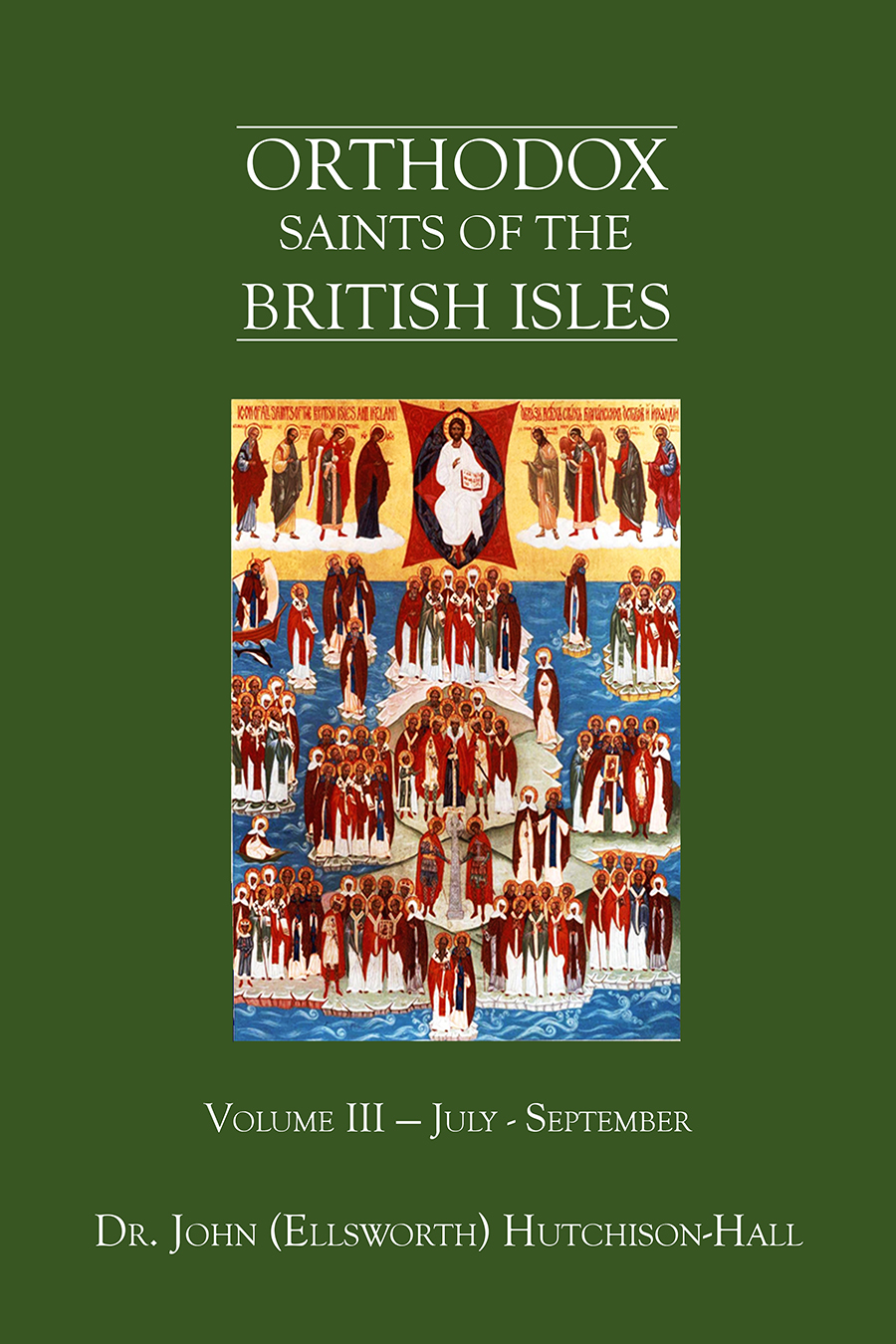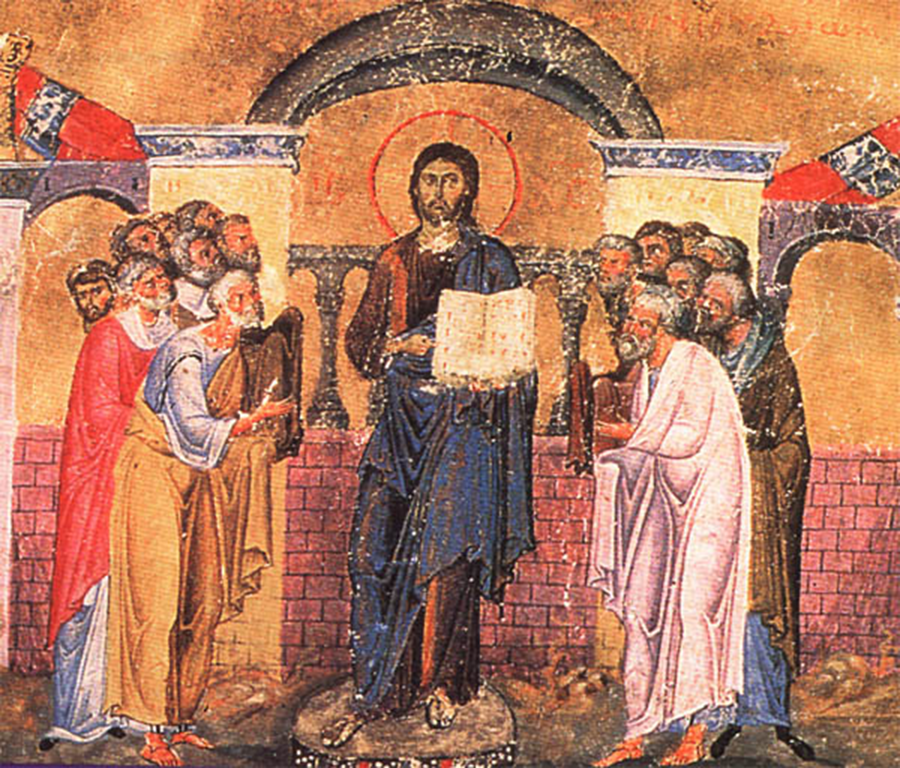
Orthodox Saints of the Pre-Schism
See of Rome
1st September (NS) — 19th August (OS) 2023
BADULF (BADOUR, BADOLF) of AINAY, an Abbot of the Abbey of St. Martin of Ainay (l'abbaye de St-Martin-d’Ainay), near Lyons in present-day France. St. Badulf reposed circa 850. Nothing else is known about him.
BERTULF of LUXEUIL, as the son of a pagan noble St. Bertulf was raised as a pagan. However, the holy live of his close relative, St. Arnulf of Metz (10th July), so inspired him that he became a Christian. In 620 he received monastic tonsure at the Abbey of SS. Peter and Paul of Luxeuil (abbaye Saint-Pierre et Saint-Paul de Luxeuil). Not long later Abbot St. Attalas of Bobbio (10th March) visited Luxeuil, and became friends with St. Bertulf. With the blessing of his Abbot, St. Eustace of Luxeuil (29th March), St. Bertulf left Luxeuil, and joined the community of the Abbey of St. Columbanus (Abbazia di San Colombano) at Bobbio in Emilia-Romagna (northern Italy). Following the repose of St. Attala in 627, St. Bertulf was elected Abbot of Bobbio. St. Bertulf reposed in 640.
CALMINIUS (CALMIN, CALMILIUS), (Sixth or Seventh Century), the founder of the Abbey of St. Peter (abbaye Saint-Pierre de Mozac) in Mozac, Puy-de-Dôme (central France); the Abbey of St. Martin (l'abbaye de saint Martin de Tulle) at Laguenne (near Tulle, south-western France), and the abbey of St. Theofrid (Chaffre) (abbaye Saint-Chaffre du Monastier) in present-day Le Monastier-sur-Gazeille, France. St. Calmininus' widow, St. Namadia of Marsat (vide infra), received monastic tonsure at the Abbay of Our Lady of Marsat (abbaye Notre-Dame de Marsat) in Marsat, Puy-de-Dôme (central France), a dependency of Mozac, upon St. Calminius’ repose. The relics of both these saints are enshrined in the abbey church at Mozac.
CREDAN of EVESHAM, (Eighth Century), St. Credan served as Abbot of Evesham in Worcestershire, England during the reign of Offa, King of the Mercians (r. 757–796). Though the details of his life are lost to the passage of time, his memory is preserved through listings in various calendars and menologies.
DONATUS of MOUNT JURA, a deacon-monk from Orléans (north-central France) who lived as a hermit on Mt. Jura near Sisteron (south-eastern France). St. Donatus reposed circa 535.
ELAPHIUS (ELAPHE) of CHÂLONS, the 17th Bishop of Châlons-sur-Marne (present-day Châlons-en-Champagne north-eastern France). St. Elaphius was sent as an envoy to Spain, but reposed whilst travelling there.
GUENNINUS, a seventh century Bishop of Vannes in Brittany (north-western France) whose relics are enshrined in the Cathedral of St. Peter (Cathédrale Saint-Pierre de Vannes) in Vannes.
JULIUS of ROME, (Late Second Century), a Roman senator who was scourged to death for being a Christian.
MAGNUS (MAGNE), a governor of Avignon (south-eastern France), and father of St. Agricola of Avignon (2nd September). Following his wife’s repose, St. Magnus received monastic tonsure at the Abbey of Our Lady of Lérins (abbaye Notre Dame de Lérins) on one of the Lérins Islands in the Mediteranian Ocean off the Côte d’Azur in France. In 646, St. Magnus was consecrated the 34th Bishop of Avignon, and appointed his son co-adjutor. St. Magnus reposed in 660
MARIANUS of ENTRAIGUES, a hermit in the forest at present-day Entraigues-sur-la-Sorgue, France. St. Marianus reposed circa 515, and St. Gregory of Tours (17th November) was the author of St. Marianus’ Life.
MARINUS of BESALU, Abbot-Bishop of the monastery of St. Peter (monasterio de San Pedro de Besalú) in Besalú, Catalonia, Spain. St. Marinus reposed circa 800.
MOCHTA (MOCHTEUS, MOCHUTA), St. Mochta, originally from either Scotland or England, went to Ireland where he became the founding Abbot-Bishop of Louth, Co. Louth. Many sources state St. Mochta flourished during the sixth century, though most assert he was consecrated Bishop by St. Patrick of Ireland (17th March), which would place him in the fifth century.
NAMADIA, the wife of St. Calminius (vide supra) who received monastic tonsure at the Abbay of Our Lady of Marsat (abbaye Notre-Dame de Marsat) in Marsat, Puy-de-Dôme (central France), a dependency of the Abbey of St. Peter (abbaye Saint-Pierre de Mozac) in Mozac, Puy-de-Dôme (central France), upon St. Calminius’ repose. The relics of both these saints are enshrined in the abbey church at Mozac.
RUFINUS of MANTUA, (Date Unknown), there is no information extant on the life of St. Rufinus, who is listed in the Roman Martyrology as a Confessor, though it is also possible he was a priest. St. Rufinus has been venerated in Mantua in Lombardy (nothern Italy) from time immemorial.
SEBALDUS of NUREMBERG (SINIBALD, SEBALD), There are no certain details of this saint’s life known to us. The various martyrologies list him as being a Frank, English, Irish, or Danish. Regardless of where St. Sebaldus was born, following a pilgrimage to Rome, he joined St. Willibald of Eichstatt (7th July) in his evangelisation of the Germans. His work seemed to have centred around the area of Nuremberg, of which city he is the patron saint. St. Sebaldus most probably reposed circa 770.
Get your copy of Orthodox Saints of the British Isles today.
Available at Amazon or your favourite e-bookstore.
AGIA (AIA, AYE), (Sixth Century), mother of St. Lupus of Sens (vide infra), she was a woman of great holiness who has been venerated as a saint since her repose.
ARCANUS, following a pilgrimage to the Holy Land, St. Arcanus founded a monastery to enshrine relics which he had brought back. This monastery grew to become Sansepolcro in Tuscany. He is believed to have reposed circa 1050.
CONSTANTIUS the BISHOP, a Bishop of Aquino (Aquinum) in Lazio (present-day Italy). St. Constantius is mentioned by Pope St. Gregory the Dialogist (3rd September) in his Dialogues, and was known for his gift of prophecy. St. Constantius reposed circa 520.
FIRMINUS of AMIENS, (Fourth Century), named for St. Firminus (25th September), who, as first Bishop of Amiens in Picardy, had baptised his father, this St. Firminus was third Bishop of Amiens.
GILES (ÆGIDIUS, GILLES), (Eighth Century), there is little in the way of reliable information on his life. St. Giles is believed to have been born in Athens, but seems to have gone to what is today Languedoc and Provence in France. There he lived primarily as a hermit, though is said to have founded an abbey in what is now the town of St-Gilles-du-Gard. The tomb in this abbey, which was rededicated to him in the tenth century, became a place of pilgrimage and a stop on the road from Arles to Santiago de Compostela. The cultus of St. Giles quickly spread throughout Europe, with numerous churches and monasteries dedicated to him in Britain, France, Germany, Hungary, Poland, Slovakia, and Spain.
LUPUS (LEU) of SENS, (Seventh Century), a member of the royal house of the Kingdom of Burgundy, who served as the nineteenth Bishop of Sens in Burgundy.
LYTHAN (LLYTHAOTHAW), St. Lythan is the patron saint of two churches in the Diocese of Llandaff in southern Wales. Nothing further, including the years he flourished, is known of his life.
NIVARD of REIMS, Bishop of Reims (north-eastern France) from sometime before 657 until his repose circa 670. St. Nivard is buried at the Abbey of St. Peter (abbaye Saint-Pierre d'Hautvillers) in Hautvillers (north-eastern France), which he had restored.
PRISCUS, according to tradition St. Priscus was one of the Seventy, and that he accompanied the Apostle Peter (29th June) to Italy, and may have been the first Bishop of Capua in Campania. It is believed to have been martyred under Nero, circa 66.
PRISCUS, CASTRENSIS, TAMMARUS, ROSIUS, HERACLIUS, SECUNDINUS, ADJUTOR, MARK, AUGUSTUS, ELPIDIUS, CANION, and VINDONIUS, St. Priscus, was a bishop in North Africa, who along with his priests, was exiled by the Arian Vandals. Finding sanctuary in southern Italy they applied themselves to pastoral work and preaching the Gospel. It is possible that some of them were appointed bishops of the Sees in which they had served.
REGULUS, a native of Africa who was forced into exile by the Arian Vandals. He settled in Tuscany (central Italy), but seems to have been martyred circa 545, when the Arian Totila, King of the Ostrogoths, (r. 541–552) and his army invaded Italy during the Gothic War (535–554).
SIXTUS (XYSTUS) of REIMS, the first Bishop of Reims, there are several traditions about him, but the most likely one says that he founded the Sees of Reims (north-eastern France) and Soissons (northern France), having been sent to evangelise Gaul by Pope St. Sixtus II (6th August). St. Sixtus reposed circa 300. Nothing more can be stated with any certainty about his life.
TERENTIAN, a Bishop of Todi in Umbria (central Italy) who was arrested during the persecution of Christians under Emperor Hadrian (r. 117–138). In 118, after being tortured on the rack, and having his tongue cut out, St. Terentian was beheaded.
TWELVE HOLY BROTHERS, there are two traditions regarding these saints. One is that they are the children of SS. Boniface and Thecla (30th August), and were martyred shortly after their parents. However, there is no reliable account of their martyrdom extant. The other is in 760, the relics of a group of martyrs in southern Italy dating from circa 303, were gathered together and enshrined in Benevento, Italy as a group then called the “Twelve Holy Brothers”.
VERENA of ZÜRICH, (Third Century) a native of Egypt who travelled to Switzerland in search of a relative who was a member of the Theban Legion (22nd September). St. Verena eventually settled as an anchoress near present-day Zürich, Switzerland.
VICTORIUS of LE MANS, sixth Bishop of Le Mans (north-western France) from circa 453, until his repose circa 490. He is said to have been a disciple of St. Martin of Tours (11th November). St. Gregory of Tours (17th November) attested to his miracles and holiness of life.
VINCENT of XAINTES and LAETUS of DAX, (Fifth Century ?), St. Vincent and St. Laetus are martyrs often said to have been natives of Spain. It is equally possible the hailed from present-day south-western France near the Pyrenees mountains. St. Vincent served as the first Bishop of Dax (south-western France), and St. Laetus was his deacon.
Prior to the Schism the Patriarchate of Rome was Orthodox, and fully in communion with the Orthodox Church. As Saint John of Shanghai and San Francisco +1966 said “The West was Orthodox for a thousand years, and her venerable Liturgy is far older than any of her heresies”.
Details of British Saints excerpted from Orthodox Saints of the British Isles.
Details of continental saints from these sources.
In many cases there are several spelling versions of the names of saints from the British Isles. I use the Oxford Dictionary of National Biography version as the primary version with the more prevalent version in parenthesis e.g. Ceadda (Chad) of Lichfield.


